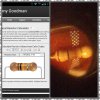73's de Edd
- Aug 21, 2015
- 3,622
- Joined
- Aug 21, 2015
- Messages
- 3,622
Thir hotrodjohn7 . . . . . . . .ohmiGawd . . I theem to have developed a lisp . . .
If you will look through your pictures I believe that you that you will see that resistor R2 is not any too happy with the AC line connections scheme either !
What I seem to be seeing here is the inter connection of two HOT AC line devices .
And you drew the short straw on your odds and are having a 60 VAC or the full 120 volts potential being between the two units, and your pot is burning up, when swung to one end of its adjustment range .
Give us the model of the olde time Monkey Warts phono, so that we can research to see if it's design is being a HOT chassis model also .
ISOLATION is supposed to be taken care of by your BLUE circled transformer . . . . .UNLESS . . . . you have a common chassis connection between two HOT chassis units, and just happened
to have gotten one of the NONPOLARIZED A.C. plugs into the wall socket 180 degrees off.
We can see that your unit, with its 4 non-polarized AC outlets is being a HOT chassis unit, we just need to know about the record player or anything else,plugged into an A.C. outlet that you're trying to tie into the unit .
73's de Edd
If you will look through your pictures I believe that you that you will see that resistor R2 is not any too happy with the AC line connections scheme either !
What I seem to be seeing here is the inter connection of two HOT AC line devices .
And you drew the short straw on your odds and are having a 60 VAC or the full 120 volts potential being between the two units, and your pot is burning up, when swung to one end of its adjustment range .
Give us the model of the olde time Monkey Warts phono, so that we can research to see if it's design is being a HOT chassis model also .
ISOLATION is supposed to be taken care of by your BLUE circled transformer . . . . .UNLESS . . . . you have a common chassis connection between two HOT chassis units, and just happened
to have gotten one of the NONPOLARIZED A.C. plugs into the wall socket 180 degrees off.
We can see that your unit, with its 4 non-polarized AC outlets is being a HOT chassis unit, we just need to know about the record player or anything else,plugged into an A.C. outlet that you're trying to tie into the unit .
73's de Edd
Last edited by a moderator:











